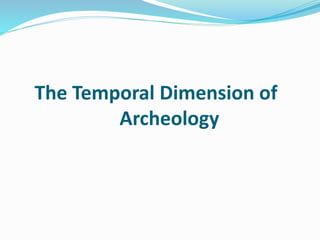
Lecture 4 temporal dimension of archeology
- 1. The Temporal Dimension of Archeology
- 2. 1. Neolithic (earliest) 8500-4300; it is used to designate a period beginning with the domestication of plants and animals and introduction of metals. Stamp seals were used for marks of identification and ownership. Irrigation and protective walls for security. Richly decorated potter articles.
- 3. This Mesopotamian terra-cotta urn (Iraq Museum, Baghdād) from the Neolithic Period dates back to between 5000 and 3000 BC. Found in the Middle East, the urn exhibits a design representative of ancient Persian art. Called “animal style,” the decoration on the vase features animals, in this case fish, used in a symbolic manner. Because ancient nomadic tribes in the Middle East left no written records or permanent monuments, the artwork buried with their dead provides the most useful information about them.
- 4. This enigmatic object, dubbed "the point," has been found in several French Neolithic necropolises. They are possibly objects of power or symbols of prestige.
- 5. 2. The Hassuna and Samarra Periods (5800- 5000 B.C.) This period falls within the 6th century millennium; Their housing is more sophisticated than at Jarmo;
- 6. Burial practices changes; dead were buried in the corner of unused rooms or in graves separated from the houses; Stamps; Primitive form of irrigation agriculture; Settlement protected by walls; Richly decorated pottery bowls
- 7. 3. The Halaf Period (5500-4500) at this period, metal slowly replaced flint and stone for tools. According to art historians, pottery during this period are the most esthetically pleasing ever made in Mesopotamia. They had the skills to make extremely thin vessels and to decorate them with sophisticated painted designs.
- 9. This bowl has been pieced together from seventeen shards from the site of Tell Halaf, in modern Syria. Approximately half of the rim is preserved with the exterior and inner side decorated with brown paint on a buff background typical of pottery belonging to the Halaf culture. Halaf pottery was made by hand (the potter's wheel was not invented until the fourth millennium B.C.) and decorated with very finely executed designs in one or two colors. This fragment of a thin walled vessel has the exterior painted with light and dark brown decoration consisting of a stylized bird in profile with back arched, a long neck, and a large circular head.
- 10. 4. The Ubaid Period (5300-3750 B.C.) Southern Mesopotamia was dotted with downs; People were normally situated along riverbanks. Invention of sailboats based on the discovery of toy boat; Elaborated temples were built on platforms .
- 12. 5. The Protoliterate Period (3750-2900 B.C.) “fast potter’s wheel” which revolutionized the ceramic industry, making it possible to increase production, standardize shapes, and employ new shaping techniques. Stamp seal to cylinder seal
- 13. Metal came into general use, and perhaps the chariot was invented Sculpture also appeared Writing is the most important contribution of this period; earliest examples are on small clay tablets found in a temple.
- 14. The Kish tablet is inscribed with proto-cuneiform signs. It may be considered as the oldest known written document. The writing purely pictographic and represents a transitional stage between proto-writing and the emergence of the syllabic writing of the cuneiform script proper. This tablet may be identified as the first document of the Mesopotamian protoliterate period.
- 15. A stone cylinder with engraved images on its surface leaves impressions when rolled on wet clay. Cylinder seals are characteristic artifacts of ancient Mesopotamian civilization and are considered some of its finest artistic achievements. The seals first appear during the Protoliterate Period (c. 3400– 2900 BC), and, although the earliest examples used primarily geometric, magical, or animal patterns, later seals incorporated the owner’s name and depicted a variety of motifs. Cylinder seals were employed in marking personal property and in making documents legally binding. Their fashioning and use were adopted by surrounding civilizations, such as those of Egypt and the Indus valley. (Encyclopaedia Britannica)
- 17. Chalcolithic Terra-cotta Cup Jug Jar Israel 3500BC •US $220.00 Chalcolithic age Terra-cotta Bowl from Israel 4000BC •US $120.00
- 18. Chalcolithic age Terracotta Cup Jug Jar 3500BC •US $170.00
- 19. 6. The Early Dynastic Period (2900-2334 B.C.) While the Protoliterate implied the beginning of writing, “”Early Dynastic” signals the onset of a new political order in Mesopotamia. At this period, they believed that kings were from heaven and passing from one city to another.
- 20. Discovery in the royal tombs during the late 1920s shows Ur’s advancement before the time of Abraham. Excavation also shows that hundreds of people died; these are people who were willing to die with their master; or servants who were drugged to a painless death. Writing expanded; scribal school appeared, word list compile, and history was written.
- 21. This is a plate from the Early Dynastic Period of Ancient Egypt (ca. 3900 BC). It depicts a man on a boat alongside a Hippo and Crocodile.
- 22. 7. Akkad (2334-2193 B.C.) Sargon, founder of Akkad who reigned for 55 years. Akkadian began to write in cuneiform.
- 23. 8. Ur III (2112-2004 B.C.) Ur-Nammu is the founder of Ur III period. Ur III is sometimes called a period of Sumerian renaissance. Sumerian became the dominant language.